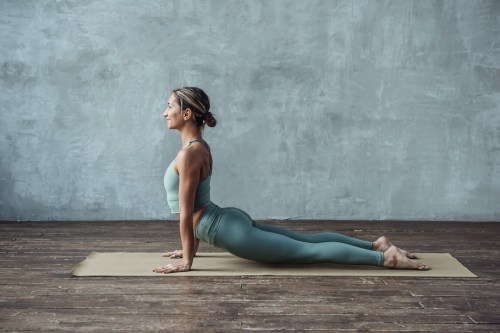Fresh-cut flowers lend so much beauty to your surroundings. And you don’t need to spend a fortune to keep your home full of blossoms. Next time you’re at the market, instead of reaching for one of the pre-made floral arrangements, consider grabbing a few bouquets and creating your own. It’s easy to make a show-stopping floral arrangement with flowers from the grocery store, says florist Conner Nesbit, owner of Leuca Floral and winner of HBO’s Full Bloom.
Experts in This Article
Conner Nesbit is a florist, owner of Leuca Floral, and winner of HBO’s Full Bloom.
“If there are flowers at your supermarket, buy a bouquet and just play around with them,” says Nesbit. “Flowers are therapy. At the end of the day, it’s not trying to make this beautiful Instagram-worthy arrangement. It’s more about the joy and the experience that flowers are bringing into my life. There’s no wrong way to design, just enjoy the process.”
When Nesbit started his business five years ago, he used grocery store flowers to create professional floral arrangements.
“I was fortunate enough to be working in a flower shop on the side, but when I started my own business, I was going to the Trader Joe’s, to the little grocery stores, and I’d buy the flowers from there. I’d turn around and create my centerpieces or my arrangements,” he says. “I would encourage everyone so much to just pick up a little bunch of flowers from the grocery store while you’re grabbing food for the week because you never know, maybe five years down the road, someone else is going to be doing flowers because they got that Trader Joe’s bouquet and sparked a passion they didn’t know was there.”
Ready to embrace your inner florist? Below, Nesbit shares five tips to guide you through the process of how to make a floral arrangement.
How to make a gorgeous floral arrangement with grocery store flowers
1. Check the flowers for freshness
Before you can decide which flowers to bring home, you want to assess your options and see which flowers look fresh.
“There are some tricks that you can do while buying [flowers] to test the quality,” says Nesbit. “Roses, for example, you can give the bud a nice squeeze and if it’s extremely soft, if you’re squishing into that rose almost like a marshmallow, you can tell those are a little bit older and those are probably going to blow open pretty quick. And they’re not going to live very long. Whereas if you squeeze that rose head and it’s kind of firm and it feels like those petals are nice and tight together, that’s a really fresh rose.”
It’s also important to check out the stems. Tulips, for example, are often packaged in a way where mold can grow down inside the leaves.
“You just want to look a little deeper into the bouquet because nothing’s worse than getting home and you unwrap these beautiful tulips and six of the 10 stems fall apart because they’ve molded through,” he says. “Don’t just look at the tops of these bouquets, pull [a stem] out, maybe turn it upside down and give it a nice gentle shake. If a bunch of stuff starts to fall out of that, you know that’s probably an older bouquet.”
2. Narrow down your selection
“Rather than trying to get a little bit of this and a little bit of that and like, ‘Oh, I want some of these roses and some of these carnations, and I have to have some of these daisies,'” says Nesbit, “maybe find just the one or two prettiest things and buy a couple bunches of all of that.”
By keeping your selection limited, building the arrangement will be easier and you don’t have to worry about trying to pull together a cohesive color palette from limited grocery store options.
“Buying anything en masse automatically will just make it look more grand. It makes it look like it has more substance and more volume,” says Nesbit. “That lonely bunch of baby’s breath, all on its own, it might not look that appealing. But if you can snatch up three or four of it for $10, $15, and put all that in a vase and just air it out, it totally transforms that flower. It gives it a whole brand new life.”
3. Prep your stems
Before you can start arranging, you want to get the stems in tip-top shape. The first step is cutting off excess leaves.
“Always, always, always, strip down the foliage, at least the lower two-thirds of the foliage,” he says. “It’s okay to leave on the little bit of leaves that are right underneath the actual bud, or the flower, itself. But you especially do not want to be adding any foliage down into your water when you’re designing with your flowers. That’s the quickest thing that will kill your flowers. Those leaves break down. They start to promote bacteria growth. That’s what makes your water really gross and yucky after a couple of days. And then that bacteria goes right up into the flower and starts to kill it.”
Next, you want to give the bottom of your stems a nice slanted cut. Some florists recommend cutting your stems under running water to prevent air pockets from getting into the stem. You can cut the stems dry if you can get them into water no more than six seconds later.
“With grocery flowers, you don’t know how long they’ve been sitting out there,” says Nesbit. “I always recommend [cutting] at least half an inch, a pretty good amount off the bottom of the stem so you know that you’re giving it a nice, fresh cut and it can start to rehydrate and drink again.”
4. Build the arrangement
Once your flowers are ready to go, Nesbit says you can start arranging them directly in your vase or in your hand. If you want to start in your vase, Nesbit says you can take a bit of masking tape or painter’s tape to make a grid on the top of your vase. This can help guide your placement.
“If you’ve purchased any greenery, start with that or your heaviest, bulkier flowers,” he says. “Build up your foundation and then start adding your lighter flowers on top of that and just weave them through.”
To arrange the flowers in your hands, you want to follow the same steps as above but in your palm.
“If you wanted to make a nice hand-tied bouquet, say you’re just dropping it down into a Mason jar, you can build out this bouquet all in your hands,” he says. Once you’re happy with your arrangement, just lightly bind it with a pretty ribbon or string and trim down the stems until they sit nicely at the base of the jar. “It’s almost like what we did in that finale challenge on the show,” he says. “I’ll do it that way quite often. I think it’s just quicker for me. And then you don’t have to fuss with the stems shifting back and forth to your vase or going back and forth.”
5. Keep them fresh
After building such a pretty arrangement, you’ll want to keep it fresh for as long as possible. Nesbit says the most important thing you can do is to regularly change the water.
“Change the water every single day,” says Nesbit. “Either change it entirely or if that’s too much of a hassle, make sure you’re adding fresh water to that arrangement. That fresh water is truly key for long-living flowers.”
If your market bouquet came with one of those little flower food packets, follow the directions on the packet and divide it up based on how much water is in your vessel and add the appropriate amount every day or every other day. Once you run out of food, just adding more water is fine. “The first couple of days, those are the big drinking days and then they start to drink less and less,” he says. “If you can get that food for those first couple of days and get that up into the flower, that’s usually the best optimal time.”
Finally, be sure to give your stems a trim every two or three days. “It’s a little bit of work if you want to keep them living as long as possible, but fresh cut, fresh water, that’ll probably double the lifespan of those flowers.”
The best plants for every room in the house:
Oh hi! You look like someone who loves free workouts, discounts for cult-fave wellness brands, and exclusive Well+Good content. Sign up for Well+, our online community of wellness insiders, and unlock your rewards instantly.
Sign Up for Our Daily Newsletter
Get all the latest in wellness, trends, food, fitness, beauty, and more delivered right to your inbox.
Got it, you've been added to our email list.











